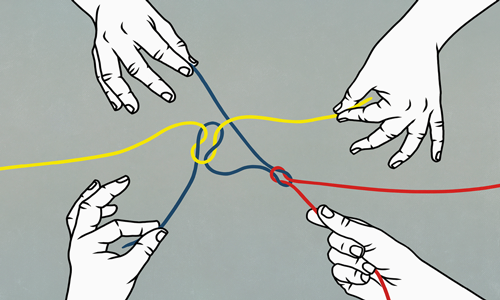“Out here, due process is a bullet,” said John Wayne,1 which may provide us with some insight into the way the United States is dealing with any number of the large-scale social issues it is facing.
However, regardless of what we are experiencing in the way of challenges, our justice system is founded on the rule of law. And no matter how expedient, convenient and pragmatic a solution we think we can effect to solve a problem, we are all bound by the rule of law and its process.
While the criminal law sphere may be where these concepts get media exposure, they are equally applicable in the most mundane of civil matters, such as probate matters.
Only a court can declare the validity of a will. The rationale for this principle is that “[s]ubject to limited exceptions, the Will is a binding determination at large, it cannot be ‘gainsaid’ even by another court”.2
It remains for a court to be satisfied on the evidence that the document being propounded is the deceased’s last valid will. Accordingly, even where parties related to the estate agree among themselves as to questions around the validity of a testamentary document, any resolution reached by them is subject to the court’s determination.3
This issue was recently addressed in the matter of Re Picking [2020] QSC 278.4 There, the deceased, Mrs Picking, made a formally executed will dated 23 October 2001.5 However, on her death on 11 March 2020,6 a copy of that will was found at her home.7
It was found by one of her executors, Wendy Elizabeth Nielsen,8 who gave evidence that the deceased informed her a year prior to her death that her will was located “at her home”.9 The copy contained a number of alterations with notations which were neither signed nor witnessed.10 The original will was eventually located and filed in the court registry.11 The question for determination was the status of the altered copy of the will.
Before probate was sought, the parties investigated the various alterations on the copy will and subsequently disclaimers of gifts made under the alteration were made with respect to those affected by the alterations. Further investigations also revealed other gifts made by the alterations were given to the recipient while the deceased was alive.12
This had the practical effect of the alterations having no real impact on the gifts in the formal will. Notwithstanding, the cooperation of the parties, the disclaimers, and the confirmation of intervivos gifts, the task for the court was to determine the status of the altered copy.
In its considerations the court acknowledged that “to give probate on the alleged codicil serves no practical purpose”.13 Notwithstanding, Davis J affirmed that “[i]t would be inappropriate to grant probate of the will without granting probate to any codicil as otherwise the will to which probate was granted could not be properly described as the last will of Mrs Picking”.14
In reaching the conclusion that the altered will so the court considered various provisions of the Succession Act 1981, including: ‘Section 10 – How a will must be executed’; ‘Section 16 – How a will may be altered’ and ‘Section 18 – Court may dispense with execution requirements for will, alteration or revocation’ in the context of the jurisprudence regarding those provisions.15
After consideration of the evidence, Davis J found the altered copy to be an informal codicil and granted probate of the formal will and informal codicil.16
In reaching his conclusion Davis J affirmed the following principles of law:
“[42] In Lindsay v McGrath,12 [2016] 2 Qd R 160. Boddice J, referring to Hatsatouris v Hatsatouris,13 [2001] NSWCA 408. explained the three requirements which must be fulfilled before the court ought make an order under s18 dispensing with execution requirements. His Honour said:
‘[57] In Hatsatouris v Hatsatouris14 [2001] NSWCA 408, [56]. Powell JA observed, in relation to the analogous provision in New South Wales: ‘It is, and has long been, my view that the questions arising on applications raising a question as to the applicability of s18A are essentially questions of fact, the particular questions of fact to be answered being:
(a) was there a document,
(b) did that document purport to embody the testamentary intentions of the relevant Deceased?
(c) did the evidence satisfy the Court that, either, at the time of the subject document being brought into being, or, at some later time, the relevant Deceased, by some act or words, demonstrated that it was her, or his, then intention that the subject document should, without more on her, or his, part operate as her, or his, Will?’
This approach has been applied in Queensland.15 Re Garris [2008] 2 Qd R 59, 8; Re Edmonson [2013] QSC 54.
[58] The second element requires a consideration of the expression ‘testamentary intentions’. In Re Masters (deceased)16 (1994) 33 NSWLR 446, 455. Mahoney JA observed:
‘…[The] document must state the deceased’s ‘testamentary intentions’, that is, his wishes or intentions as to how, voluntarily, his property is to pass or be disposed of after his death. A will may, of course, do other things: it may, for example, appoint a legal personal representative, exercise a special power, appoint a guardian or the like: see Halsbury’s Laws of England, par 202. But it is the disposition of the deceased’s property voluntarily after his death which is, for present purposes, the relevant characteristic of a will.’
[59] The third requirement requires the Court to be satisfied on the evidence that the deceased, either at the time of drafting the document or subsequently, formed the intention that the particular document operate as his or her Will. That requirement does not involve establishing that the deceased consciously set his or her mind to the legal formalities of making a Will.17 Hill v Plummer per Kirby P (as his Honour then was), 452. However, it is not enough that the document set out the deceased’s testamentary intentions. What must be established, by evidence, is that the deceased intended the document to operate to dispose of the deceased’s property upon death.18 Oreski v Ikak [2008] WASCA 220, [54].” (footnotes in original)
Since section 18 was introduced into the Succession Act 1981, in 2006 (replacing section 9(a) and (b) of the existing Act) a wide range of material has been considered by the court under that provision.17 Add to the mix COVID-19 and the statutory and regulatory changes Queensland has made to the manner in which testamentary instruments may be executed and witnessed, and I expect a greater number of potential section 18 application to come across our desks in the near future. To that end the takeaways for practitioners are:
- Any material may fit the s18 requirements, no matter how inconsequential; therefore it ought to be thoroughly investigated.
- Only a court can make the determination as to whether is a testamentary instrument on an application for a grant.
- Parties to a matter themselves cannot resolve whether the material constitutes a testamentary document, only a court can do that.
- However, whatever reasonable steps they can take to minimise the court’s time and costs ought to be considered.
- If your client feels disinclined to follow the above recommendations, preferring John Wayne’s method, it might assist to advise your client he also observed that “Life is hard; it’s harder if you’re stupid.”
Christine Smyth is a former President of Queensland Law Society, a QLS Accredited Specialist (succession law) – Qld, a QLS Senior Counsellor and Consultant at Robbins Watson Solicitors. She is an executive committee member of the Law Council Australia – Legal Practice Section, Court Appointed Estate Account Assessor, and member of the Proctor Editorial Committee, STEP and Deputy Chair of the STEP Mental Capacity SIG Committee.
Footnotes
1 John Wayne, Carol Lea Mueller (2007). The Quotable John Wayne: The Grit and Wisdom of an American Icon, p60, Taylor Trade Publications.
2 McKeown at [13] citing Williams, Mortimer and Sunnucks, Executors, Administrators and Probate, 20th ed (2015) at p 564 [40-02].
3 For a more recent recitation of this principle see McKeown v Harris & Anor; In the Will of Patricia Margaret Rice [2018] QSC 87.
4 Re Picking.
5 At [6].
6 At [8].
7 At [9].
8 ‘Wendy’.
9 At [7].
10 At [13]-[20].
11 At [11].
12 At [20]-[25].
13 At [43].
14 At [43]-[44].
15 At [37]-[59] citing: Hatsatouris v Hatsatouris [2001] NSWCA 408, followed and Lindsay v McGrath [2016] 2 Qd R 160, followed.
16 At [48].
17 For various examples see: Tolbert v Hicklin [2020] QSC 166 (10 June 2020) – solicitor’s instruction notes signed by the deceased; Saltmer v Rennick Lawyers Pty Ltd [2018] QSC 307 (18 December 2018) – will instructions on an insurer’s checklist; GEW, Re [2020] QSC 119 (30 March 2020) – suicide note; Re: Tinker (d’ced) [2016] QSC 217 (21 September 2016) – letter written in contemplation of suicide; In The Estate of Leslie Wayne Quinn (deceased) [2019] QSC 99; Radford v White [2018] QSC 306; Mellino v Wnuk & Ors [2013] QSC 336 [2014] 01 QLR (13/4090) Dalton J 27 November 2013 (delivered ex tempore) – video wills variously recorded on computers and iPhones; Re Nichol; Nichol v Nichol [2017] QSC 220 (9 October 2017) – unsent text message; Yu, Re [2013] QSC 322 (6 November 2013) – documents on an iPhone; Estate of Carrigan (deceased), Re [2018] QSC 206 (6 September 2018) voice mail message on the mobile telephone; Trust Company Ltd & Anor v Oates & Ors [2009] QSC 282 – document titled ‘Trust Use Only Additional Notes’.













One Response
Love the John Wayne wuote!